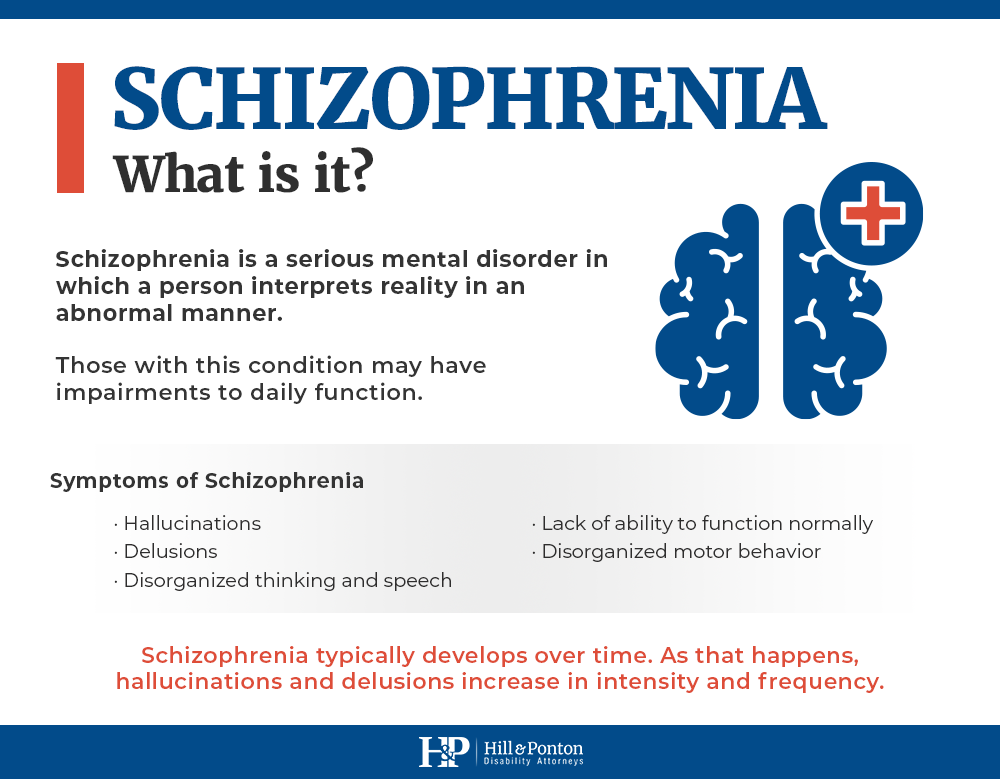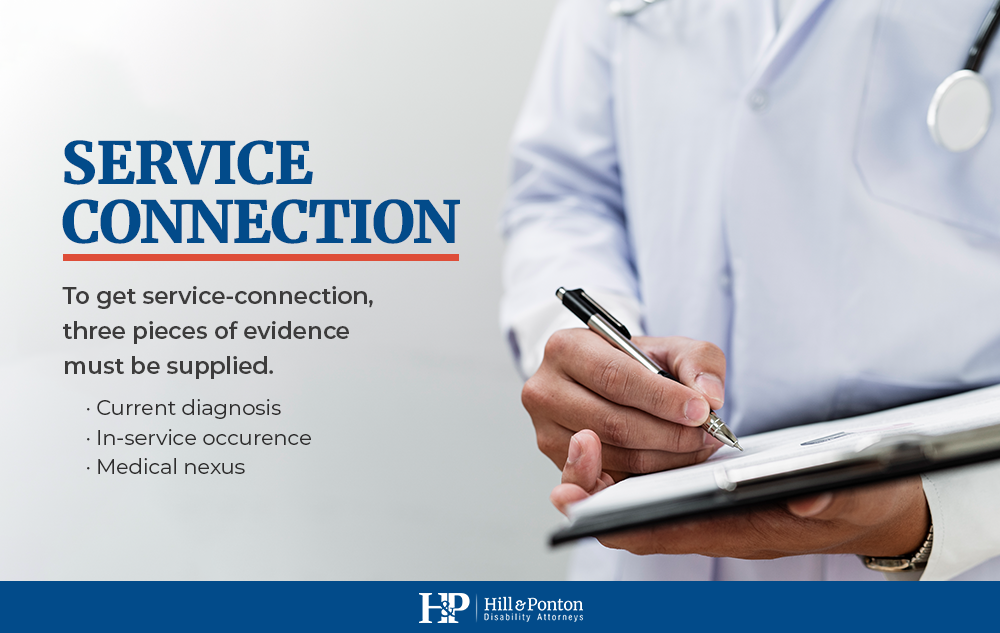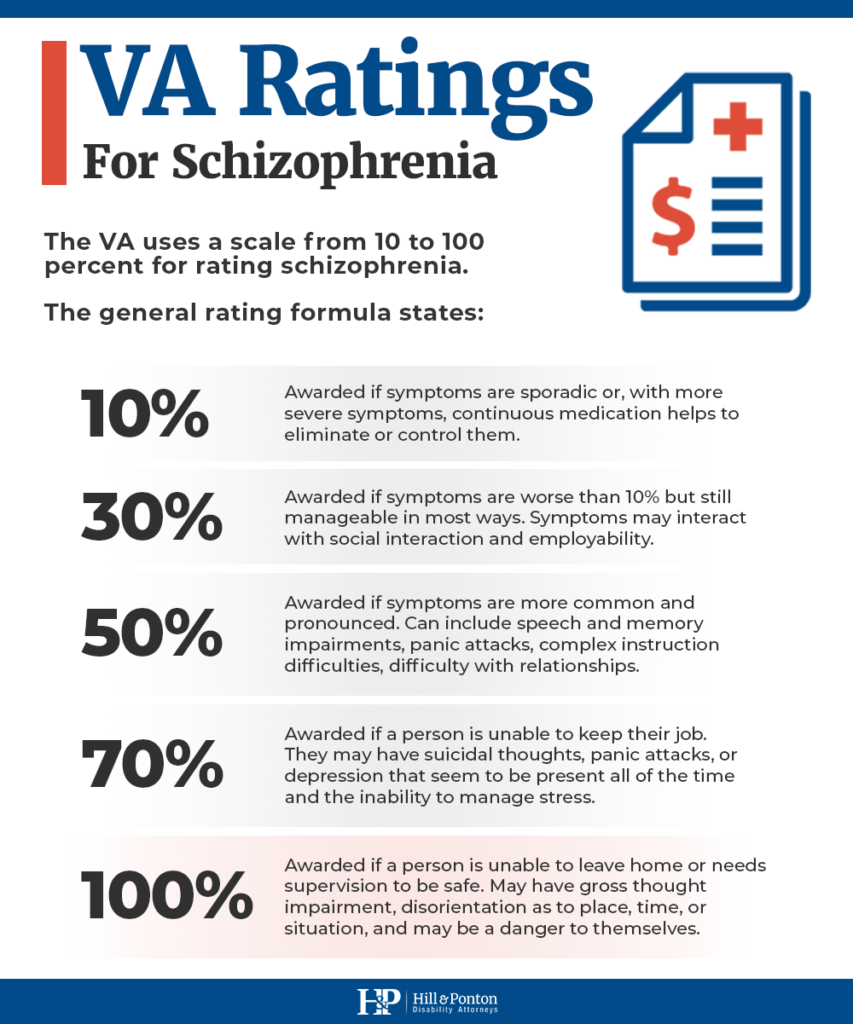For those struggling with schizophrenia, it is critical to have access to the level of care you need to thrive. As a viable disability, this condition may limit your ability to engage in meaningful work or accomplish many tasks. Learning more about a VA disability rating for schizophrenia may help you know a bit more about what to expect. Let’s take a closer look at what you can expect from this process.
What is Schizophrenia?
The Mayo Clinic states that schizophrenia is a serious mental disorder in which a person interprets reality in an abnormal manner. It may be the result of delusions, hallucinations, and disordered thinking and behavior. Those with this condition may have impairments to daily function. Symptoms of this condition include:
Common Symptoms of Schizophrenia
- Hallucinations – seeing things or hearing things that are not there or do not exist
- Delusions – having false beliefs that are not based on reality
- Disorganized thinking and speech – an inability to communicate and put words together into meaningful sentences
- Negative symptoms – lack of ability to function normally, or a reduced ability to do so, such as due to personal hygiene neglect or lack of emotion
- Extremely disorganized motor behavior – engaging in childlike behavior or experiencing unpredictable agitation
What is schizophrenia? Watch this video to learn more about what this condition is and how it impacts a person’s daily life. Learn what it’s like to live with schizophrenia.

Service Connection for Schizophrenia
To file a direct service-connected claim, a survivor of a veteran must provide evidence of the existence of the condition. There are three components to this process:
- Have a current diagnosis of schizophrenia and any other condition that you plan to claim
- Have an in-service occurrence or incident of the condition that caused or aggravated the disability, in this case, schizophrenia
- Have a medical nexus that connects the current, diagnosed condition to the in-service occurrence or incident
How does this apply to schizophrenia? It is possible to obtain a service connection for this condition but to do so, there are several things that must happen first. The first step is to show that you actually have the condition by having a formal diagnosis of it from a recognized medical provider. The second is to show that some incident occurred during service related to the condition or that the work you were doing impacted your mental health disorder. Then, link these to each other.
Schizophrenia typically develops over time. As that happens, hallucinations and delusions increase in intensity and frequency. While this condition can impact everyday activities, high stress periods, such as those that occur during high-stress active duty or challenging environments, can trigger hallucinations.
A person may believe they see someone present that is not there. They may state that they just talked to someone, and they did not. If these types of events occurred or others, it’s important to show that they impact your ability to serve. Outlandish behavior, such as sudden outbursts, can create a dangerous situation. Childlike behavior may occur when stress levels are high and is uncontrollable.

Secondary Service Connection for Schizophrenia
When filing a VA compensation claim, it may not immediately be clear that a secondary disability should also be noted. A secondary disability is one that aggravates or causes a new or pre-existing condition, injury, or illness. As a mental health disorder, it may be hard to notice that schizophrenia has impacted your life and created a secondary problem. However, this is any type of physical or mental health condition that is the result of having schizophrenia.
For example, some people with this condition are prone to suicide attempts. Others may have intense anxiety disorders or obsessive-compulsive disorder that develops over time. Others turn to drugs or alcohol as a way to calm their mind. It may even lead to depression in some people. You may struggle with panic attacks that limit your ability to manage the tasks at hand. As with all types of mental health conditions, including bipolar disorder and post-traumatic stress disorder, you need to prove what’s occurring with your mental illness.
If you have a clear diagnosis of any of these conditions and they followed the onset of schizophrenia, this may be a direct correlation, and it may qualify as a secondary service connection. Examine how the condition has impacted your health and mental wellbeing. Look for examples that demonstrate this throughout your military service, too.
Compensation & Pension Exams for Schizophrenia
To obtain disability benefits, most individuals must sit for a compensation and pension exam for their disability claims. During this process, a VA healthcare provider or a VA contracted provider will gather evidence on your disability claimed condition. The information they provide may result in a decision to award disability benefits to you and assign a rating. These examples may be used to:
- Confirm or deny service connection
- Establish the severity of the disability
The examiner will review all information provided in your claims file. This should include any submitted evidence of the disability as well as any medical treatment records.
There are a few things to do prior to this exam. Be sure you fully understand what is about to happen and, if necessary, speak to a law firm about your needs. This can help you to get more insight into what to expect and any limitations you may face. Don’t blow off the exam but be sure you attend it. During the exam, do not lie or exaggerate your claims. Be open and honest about what you experience.
If you do not get favorable results, seek legal advice. This type of medical condition is quite challenging, and even with good medical records, it can be difficult for psychotic disorders like this to be clearly examined and understood. Your attorney may help you in determining your eligibility and correcting any problems that may have led to the limited outcome.

How Does the VA Rate Schizophrenia?
To determine disability compensation and VA disability benefits, the VA uses a scale from 10 to 100 percent for rating schizophrenia. This typically includes related mental disorders such as schizoaffective disorder and related conditions such as major depressive disorder. The general rating formula for mental disorders applies in this way for schizophrenia:
- 10%: Symptoms are sporadic or, with more severe symptoms, continuous medication helps to eliminate or control them.
- 30%: Symptoms are worse than 10% but still manageable in most ways. Symptoms may interact with social interaction and employability, even if you are able to function satisfactorily.
- 50%: Symptoms are more common and pronounced and may include speech impairment, memory impairments, panic attacks that happen weekly, complex instruction difficulties, difficulty with social relationships.
- 70%: A person is unable to keep their job. They may have suicidal thoughts, panic attacks, or depression that seem to be present all of the time and the inability to manage stress. Many also show signs of personal hygiene neglect.
- 100%: This disability rating indicates a person is unable to leave home or needs constant supervision to be safe. They may have gross thought impairment, disorientation as to place, time, or situation, and may be a danger to themselves.
The VA will look carefully at the way you engage and interact as well as the symptoms you describe. Their goal is to determine if your symptoms are disabling. To determine your outcome, the VA examiner is likely to use all organized evidence provided as well as information from your attorney if you have one. They may also take into account statements and information provided by friends and coworkers based on how schizophrenia has impacted your ability to live life or engage in work-related tasks. They may ask questions to gather a full picture of what is occurring.
TDIU for Schizophrenia
Can you get total disability based on individual unemployability for schizophrenia? To reach this level and obtain this type of disability compensation, a person must demonstrate that they are unable to work. Most commonly, they must be unable to leave their home, or they must show that they are able to engage in only marginal employment. Most often, these individuals need to have constant supervision because their symptoms are uncontrolled and near constant.
What to Expect
Obtaining VA benefits for schizophrenia is an option for those who have symptoms that are significant and disabling enough to make it difficult to work or engage in life. Though a complex condition, many people may be able to qualify for disability with clear evidence of this impact.





